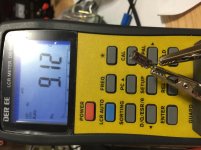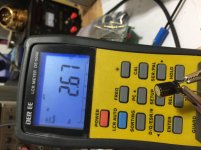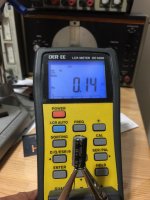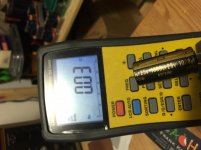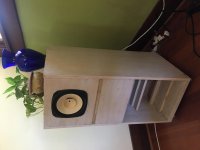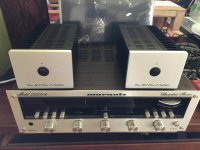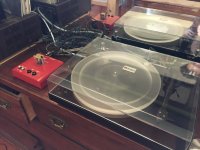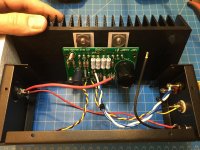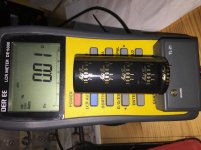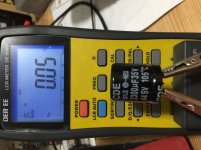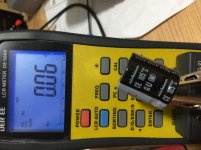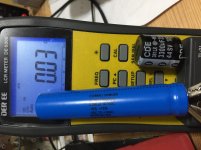I did a preliminary impedance measurement of my speakers, they came at 5.9 Ohms, ... The point is that my speakers have low impedance.
Not really.
If they were 3 ohms I might be concerned. 5.9ohm is actually better than a standard 4-ohm speaker, and there are many people reporting plenty of power with those. My tests with a 4-ohm speaker have been very good.
... However, it does appear that my speakers will consume more current when needed than the standard 8 Ohm ones.
Technically true, but see above.
I am planning to build the standard ACA 1.6 monoblock balanced inputs, and everything I have purchased already maintains the values in the schematic.
Good! That will work well.
Mine will be standard ACA 1.6 boards only modified by changing the electrolytic caps to more musical ones.
Because the ones that Nelon Pass has selected aren't musical???
So, let's say that I may, at least occasionally, need more current flowing to my speakers, maybe beyond what the standard circuit config may provide.
Um... Again, see above.
This is the question: Extreme Boky posted his system changes and he has C1, the output coupling cap, beefed up to 10,000 uF in parallel with a 2.2 film cap. I can get a suitable 10,000 uF cap in the musical (series II Gold Tone KG) Nichicon series, and I can get a nice and not gigantic 2.2 uF metal film cap to replace the circuit's C1 as specified.
Sound like fun. Fancy parts are pretty.
Because of the parallel arrangement, the overall capacitance at the C1 spot will be low, but the capacitors will be able to hold a lot more current than the 3300 uF cap specified in the schematic. Would this be an adequate solution to the, so far only potential, issue of not having enough current available at amplifier level to cover the needs of my 5.9-ohm speakers?
It's not going to make one bit of difference.
That cap is there to block DC and to let AC pass. That's it. The capacitor is not a PSU reservoir or filter cap that can act as a reservoir.
The circuit needs to have a number of points set to various DC values to operate, and that DC can't get to the speaker. Remember, the music is all AC. (It's a wave, right?
As for more current, all you could do is have a really big power supply - a PSU that will have MUCH more power than the output transistor can pass. Luckily that's already been thought of, as the supplied bricks are 150W for a 5 W amp.
Please let me know if this is a viable solution to cover a potential and occasional need for increased current availability from the amplifiers. This is something I can do with no problems, is it a reasonable thing to do?
TL;DR - Increasing the value of the coupling cap will not change the current delivery of the amp.
Last edited:
Oh that’s interesting. So my modi dac which has an output of 2V is just passed along. So basically I have a 2 volt output from my saga when using that dac?
Correct. The potentiometer in the Saga takes that signal and attenuates it down. (Unless the volume knob is cranked all the way up, in which case the DACs full output is sent through.)
Hello Anand
I know you kindly sent a link to Nelson Pass' statements saying that the ACA output is the same for the stereo version as for the monoblock. However, if you go to the ACA KIt 1.6 entry (sold out) in the diyaudio store and scroll down to the specifications you will find it clearly stated that the output for the stereo version is 8w per channel and the output for the monoblock version is 15w per channel. So, the output doubles even though the gain per (? board) stays the same. What am I missing here?
Differential signal halves will now receive an ACA, each - double the power at the point of summation = speakers, albeit for 8 and 16-ohm speaker impedance. However, a damping factor will decrease...
Parallel: the input signal is fed equally to both ACA's. Everything stays the same, current capability of the output stage increases - better for 4 ohms (and lower) impedance. The input impedance will be half. The damping factor will increase -> opens the possibility to go to 14 dB gain on each ACA
Thank you so very much 6L6, I will continue the plans with no changes to the values in the schematic. I really am grateful for your help.
To clarify the point of the musicality of the capacitors, I used the descriptions of features and functionality provided in the data sheets of the manufacturers. The 3300 Chemi cons datasheet did not mention audio or music. The Nichicons did make a primary point about the use of these products for high-grade audio equipment. That is all. The other two mods I will do will be installing Allo CMs and increasing the ventilation of the units by drilling additional vents in the top and bottom plates.
Again, thank you very much.
To clarify the point of the musicality of the capacitors, I used the descriptions of features and functionality provided in the data sheets of the manufacturers. The 3300 Chemi cons datasheet did not mention audio or music. The Nichicons did make a primary point about the use of these products for high-grade audio equipment. That is all. The other two mods I will do will be installing Allo CMs and increasing the ventilation of the units by drilling additional vents in the top and bottom plates.
Again, thank you very much.
SYclotron Audio | Why are people obsessed with coupling caps?
SYclotron Audio | Why are people obsessed with coupling caps? Part 2
That said, I still stand by what I said earlier - the fancy parts are pretty.
SYclotron Audio | Why are people obsessed with coupling caps? Part 2
That said, I still stand by what I said earlier - the fancy parts are pretty.
Last edited:
ESR TEST OF 10uF and 1000uF
One of the qualifications of a high-quality audio capacitor is ESR and lower is supposed to be better ?. This is what I found comparing Nichicon, and the kit caps. When trying to get fancy larger big-name capacitors will you changing amp camp amp smooth tubey like sound for a more sterile fast acting sound?. I guess this is what experimentation is for an exactly what this amplifier in brings out the tinker in every person learning by trial and fire 🔥. Every time I read one of my questions get answered 10 more take its place. Look at the photos below my tester for an ESR meter DER EE DE-5000 Below photos show the capacitors been tested
One of the qualifications of a high-quality audio capacitor is ESR and lower is supposed to be better ?. This is what I found comparing Nichicon, and the kit caps. When trying to get fancy larger big-name capacitors will you changing amp camp amp smooth tubey like sound for a more sterile fast acting sound?. I guess this is what experimentation is for an exactly what this amplifier in brings out the tinker in every person learning by trial and fire 🔥. Every time I read one of my questions get answered 10 more take its place. Look at the photos below my tester for an ESR meter DER EE DE-5000 Below photos show the capacitors been tested
Attachments
Choosing a sound coupling cap is the exercise that should be performed purely by listening to the end result. One should choose what best suits his system and his listening preferences. Metalized film capacitors, especially a mix of silver and gold, will have a more pleasing sound, that provides for an enjoyable listening, compared to low ESR electrolytes that measure "good", for example. Dipped in oils/waxes and specifically wound and finished/encapsulated... everything will make a noticeable difference that can't be measured, but it can be heard.
Even the latest First Watt amplifiers use a shiny nice looking white, film, sound-coupling capacitors with "PASS" written on it. And we all know the saying... if it's good for Mr Pass, it must be good for the rest of the mortals.
Even the latest First Watt amplifiers use a shiny nice looking white, film, sound-coupling capacitors with "PASS" written on it. And we all know the saying... if it's good for Mr Pass, it must be good for the rest of the mortals.
Hello, all,
I've been lurking around these pages for a while now. I purchased the ACA v1 kit about 5 years ago and finally built it this summer. I'm a complete newbie when it comes to electronics, but the ACAs are working and haven't gone up in smoke (yet)! The ACAs are driving the Fostex 206e drivers mounted in back loaded horn enclosures. Initially, I must say I was a a bit disappointed in the sound. It sounded pretty flat and lifeless compared to my trusty old Marantz 2220B. However, after running the ACAs for a while, and introducing some EQ to the signal, I'm really starting to dig the ACAs. At this point, I'm just playing Spotify from my computer direct in to the ACAs and it's sounding great.
However, I'm having a heck of a time getting my turntable to work with the ACAs. I have the turntable going in to a Bellari Tube Phono Preamp, which is going in to the ACAs. This is generating a terrible hum. I assume it's a ground issue of some kind, and I've tried every configuration of power sourcing (plugging all components into the same outlet, different outlets, etc.) that I can think of with no luck. I'm perplexed because I don't have any such problem when using the Marantz to drive the speakers.
Has anyone else run into something similar with the ACAs, and if so, any suggestions? I haven't been able to find any posts that address this issue, so posting here, along with a few photos of the setup.
Also: a general word of thanks to the diyaudio community on all the great info, build guides, etc. to be found in these forums! It's a pretty marvelous rabbit hole to have fallen into
I've been lurking around these pages for a while now. I purchased the ACA v1 kit about 5 years ago and finally built it this summer. I'm a complete newbie when it comes to electronics, but the ACAs are working and haven't gone up in smoke (yet)! The ACAs are driving the Fostex 206e drivers mounted in back loaded horn enclosures. Initially, I must say I was a a bit disappointed in the sound. It sounded pretty flat and lifeless compared to my trusty old Marantz 2220B. However, after running the ACAs for a while, and introducing some EQ to the signal, I'm really starting to dig the ACAs. At this point, I'm just playing Spotify from my computer direct in to the ACAs and it's sounding great.
However, I'm having a heck of a time getting my turntable to work with the ACAs. I have the turntable going in to a Bellari Tube Phono Preamp, which is going in to the ACAs. This is generating a terrible hum. I assume it's a ground issue of some kind, and I've tried every configuration of power sourcing (plugging all components into the same outlet, different outlets, etc.) that I can think of with no luck. I'm perplexed because I don't have any such problem when using the Marantz to drive the speakers.
Has anyone else run into something similar with the ACAs, and if so, any suggestions? I haven't been able to find any posts that address this issue, so posting here, along with a few photos of the setup.
Also: a general word of thanks to the diyaudio community on all the great info, build guides, etc. to be found in these forums! It's a pretty marvelous rabbit hole to have fallen into
Attachments
Ok last question and I think I’ve got it. If my pre amp in this config will only output 2 volts, and the input sensitivity of the aca is 2.3 ish as people are saying then 2 things.Correct. The potentiometer in the Saga takes that signal and attenuates it down. (Unless the volume knob is cranked all the way up, in which case the DACs full output is sent through.)
- I will not be able to get the aca to its full potential (8 watts)
- I won’t be able to go into clipping either cuzz this pre amp won’t send more than 2 volts
Hello, all,
I've been lurking around these pages for a while now. I purchased the ACA v1 kit about 5 years ago and finally built it this summer. I'm a complete newbie when it comes to electronics, but the ACAs are working and haven't gone up in smoke (yet)! The ACAs are driving the Fostex 206e drivers mounted in back loaded horn enclosures. Initially, I must say I was a a bit disappointed in the sound. It sounded pretty flat and lifeless compared to my trusty old Marantz 2220B. However, after running the ACAs for a while, and introducing some EQ to the signal, I'm really starting to dig the ACAs. At this point, I'm just playing Spotify from my computer direct in to the ACAs and it's sounding great.
However, I'm having a heck of a time getting my turntable to work with the ACAs. I have the turntable going in to a Bellari Tube Phono Preamp, which is going in to the ACAs. This is generating a terrible hum. I assume it's a ground issue of some kind, and I've tried every configuration of power sourcing (plugging all components into the same outlet, different outlets, etc.) that I can think of with no luck. I'm perplexed because I don't have any such problem when using the Marantz to drive the speakers.
Has anyone else run into something similar with the ACAs, and if so, any suggestions? I haven't been able to find any posts that address this issue, so posting here, along with a few photos of the setup.
Also: a general word of thanks to the diyaudio community on all the great info, build guides, etc. to be found in these forums! It's a pretty marvelous rabbit hole to have fallen into
Google “bellari tube phono hum” and you will find this is a very common issue especially for one’s manufactured during a certain time period. I believe bellari used to fix them, but I don’t know if that time has passed. Some people even pick up radio stations with them. But lots of people like them, so...
Try orientating it differently, maybe keep it away from the ACA’s more, meaning more distance. Even replace the cheap wall watt plug with a new plug... those are the things that have worked for a lot of folks.
Got it.Azookey,
If you only input a max of 2V RMS to the ACA in the standard stereo configuration it will output about 7V RMS into 8 ohms or about 6.23 Watts.
Best,
Anand.
fascinating to know that in my room with my setup only using 6-7 watts is plenty loud. Before building this I was borrowing a friends old nad 2200 with 100 watts per channel, yet I guess never even came close to using all of those , certainly considering that amp has a higher gain.
We've packed the PCB's and they now have to be sent to the fulfillment company. Should be less than 2 weeks for them to be in the store.
Athough I'm surprised that Puggie doesn't build his amp "dead bug" style, just soldering the component leads together! It's easy enough on an amp this simple Or use unmetalized perf board, where you just stick the leads through and twist them then solder..
Or use unmetalized perf board, where you just stick the leads through and twist them then solder..
Seems it would fit this amps style!
Athough I'm surprised that Puggie doesn't build his amp "dead bug" style, just soldering the component leads together! It's easy enough on an amp this simple
Seems it would fit this amps style!
I've no intention of buying the kit or chassis. I'm making this from:
left over heatsink from another project + aluminium from work's scrap bin. that is my chassis.
As many passives as I can scavenge from the University Electronic Engineering dept + a minimal spend from RS or similar for the few transistors needed
PSU from the computing dept Weee bin
I'm lazy so if gerbers/eagle files were out there I would just etch my own pcbs from scrap FR4 offcuts in EE again.
I was hoping to turn this amp out for about the same cost a 4 pints of decent beer and make myself far too much work compared to buying a kit (but that is DIY isn't it).
This means no disrespect to the people that put these kits together and sort all this out. I'm just a proper tight ****/skinflint/penny pinching/yorkshire man
p.s. another tech question. What is the anticipated current draw from a single channel at 24v, I've found a couple of open frame switch mode supplied that would fit in the casing but they are about 60w only.
Hmmm, just spoted the last post. maybe if I concentrate of the chassis first, if the PCBs are in i will buy them, if not I'll fire up eagle and see what I can remember!
Last edited by a moderator:
I have the original ACA 1.1's monoblocks, so I like the sound. I am also building the M2X for my front L and R. I was thinking of building a three channel amp with one M2x channel for the center channel and 2 ACA xlr balanced units (so 4 boards) for the 2 surround channels.
Would 4 ACA boards fit on a 3U x 400 heatsink and would the heatsink be sufficient?
Could I use the M2x power supply (using 2x18VAC torrid, DIYaudiostore PS board) to power the ACAs (positive rail)?
Would 4 ACA boards fit on a 3U x 400 heatsink and would the heatsink be sufficient?
Could I use the M2x power supply (using 2x18VAC torrid, DIYaudiostore PS board) to power the ACAs (positive rail)?
C1 cap test ESR
extreme-boky. Yes I have read about the exotic capacitors was thinking of using any more reasonably priced and sized film capacitor but decided to stick with what fits on the board and later do some A to B testing. I have three set of the early Amp came PCB from a few months ago, I built my stereo version with BOM then started playing by substituting parts from other projects I had and parts that my instructor from class gave me from electronics 101 . Working on the 1.6 right now slow progress and for testing I’ll build another 1.6 version ( extremely modified with a few in unobtaintieum NOS )Parts. Will build with the kit components and do A to B comparison with the switcher.
Here are some of the measurements I found on the C1 cap.
6L6 information that C1 is just to reduce DC or (Block) doses this work on the same principle as a power supply?. When you want to reduce Amp ripple? Where one capacitor is good but three smaller ones work better?. Because each size has a different “ banpass?” Frequency ? Not sure that’s the right word to use. Should a CAP ment and designed for a power supply may have a edge in place of C1 ?. Is this one of cases where CAPs of three smaller, different materials , electrolytic, Tantium , foil ?. From my reading about power supplies and cleaning power. I’m a nube still learning. I know we are playing with a little economy sports car and we are trying to turn it into a Ferrari. But it’s fun learning and you don’t get all greasy and bust your knuckles.
The long blue Cornell Dubilier Is for high-speed switching power supplies according to their data they brag about being ultra low ESR .
Thank You 6L6 absolutely superb build a guid. To everybody that throws out Tad bits of information for us beginners and very helpful are your occasional links to other articles to read about more in depth about electronics in amplifier builds .
Can somebody post a link showing how to set up a Oscilloscope to measure for DC riding on our speaker signal .
extreme-boky. Yes I have read about the exotic capacitors was thinking of using any more reasonably priced and sized film capacitor but decided to stick with what fits on the board and later do some A to B testing. I have three set of the early Amp came PCB from a few months ago, I built my stereo version with BOM then started playing by substituting parts from other projects I had and parts that my instructor from class gave me from electronics 101 . Working on the 1.6 right now slow progress and for testing I’ll build another 1.6 version ( extremely modified with a few in unobtaintieum NOS )Parts. Will build with the kit components and do A to B comparison with the switcher.
Here are some of the measurements I found on the C1 cap.
6L6 information that C1 is just to reduce DC or (Block) doses this work on the same principle as a power supply?. When you want to reduce Amp ripple? Where one capacitor is good but three smaller ones work better?. Because each size has a different “ banpass?” Frequency ? Not sure that’s the right word to use. Should a CAP ment and designed for a power supply may have a edge in place of C1 ?. Is this one of cases where CAPs of three smaller, different materials , electrolytic, Tantium , foil ?. From my reading about power supplies and cleaning power. I’m a nube still learning. I know we are playing with a little economy sports car and we are trying to turn it into a Ferrari. But it’s fun learning and you don’t get all greasy and bust your knuckles.
The long blue Cornell Dubilier Is for high-speed switching power supplies according to their data they brag about being ultra low ESR .
Thank You 6L6 absolutely superb build a guid. To everybody that throws out Tad bits of information for us beginners and very helpful are your occasional links to other articles to read about more in depth about electronics in amplifier builds .
Can somebody post a link showing how to set up a Oscilloscope to measure for DC riding on our speaker signal .
Attachments
Can somebody post a link showing how to set up a Oscilloscope to measure for DC riding on our speaker signal .
Much easier than you think and no Oscilloscope required -
1) Set Multimeter to DC volts.
2) Place leads across speaker terminals.
3) Read voltage (if any)
@spryor
1. move the ACA's away from the receiver. the receiver transformer may be causing interference
2. Untangle the cables; separate mains cabling from low-signal interconnects. Use well-shielded interconnects between pre-amp and ACA's
3. Use a well-regulated DC power supply for the pre-amp, instead of a 12v AC power-pack
1. move the ACA's away from the receiver. the receiver transformer may be causing interference
2. Untangle the cables; separate mains cabling from low-signal interconnects. Use well-shielded interconnects between pre-amp and ACA's
3. Use a well-regulated DC power supply for the pre-amp, instead of a 12v AC power-pack
I have the original ACA 1.1's monoblocks, so I like the sound. I am also building the M2X for my front L and R. I was thinking of building a three channel amp with one M2x channel for the center channel and 2 ACA xlr balanced units (so 4 boards) for the 2 surround channels.
Would 4 ACA boards fit on a 3U x 400 heatsink and would the heatsink be sufficient?
Could I use the M2x power supply (using 2x18VAC torrid, DIYaudiostore PS board) to power the ACAs (positive rail)?
The SMPS does not sag the voltage when supplying 3A to ACA's, well, the drop is 2-4 mV (!!!). I think it is an exceptional solution for ACA, where keeping the V+ at 24V to overcome the MOSFET's capacitance shortcoming is critical (the amplifying MOSFET will see only 12V). The conventional power supply will drop to 22V DC when supplying 3A constant current.
The SMPS will also provide exceptionally flat output impedance at full audio spectrum (the all-important high-frequency range included
PSU alternative: Meanwell RS-150-24 for Camp Amp?
Hi Guys,
I hope I`m in the right spot here, if not @admin please give me a note.
I would like to share a question regarding a power source unit for the new 1.6. I would like to use this one:
PSU Meanwell RS-150 – 24
Datasheet here
Is there anyone who used this and can recommend? How is it regarding sound etc.?
or is it better to build a PSU "from scratch" with the pcbs from diyaudio.com.
thanks much in advance, cheers from germany
futuromat
Hi Guys,
I hope I`m in the right spot here, if not @admin please give me a note.
I would like to share a question regarding a power source unit for the new 1.6. I would like to use this one:
PSU Meanwell RS-150 – 24
Datasheet here
Is there anyone who used this and can recommend? How is it regarding sound etc.?
or is it better to build a PSU "from scratch" with the pcbs from diyaudio.com.
thanks much in advance, cheers from germany
futuromat
- Home
- Amplifiers
- Pass Labs
- Amp Camp Amp - ACA
